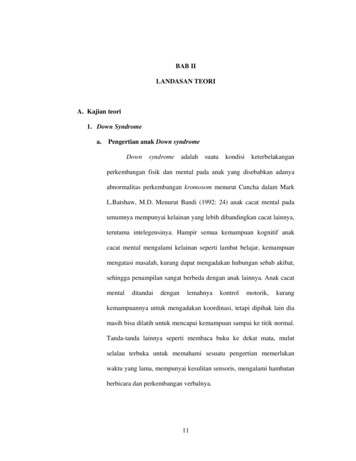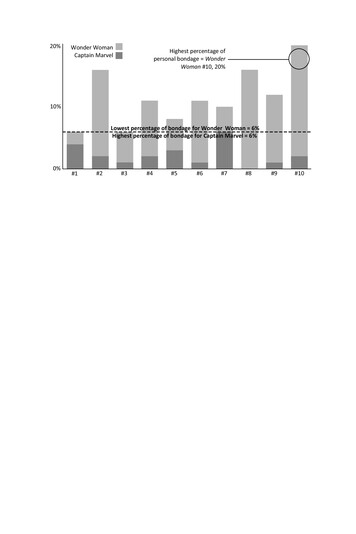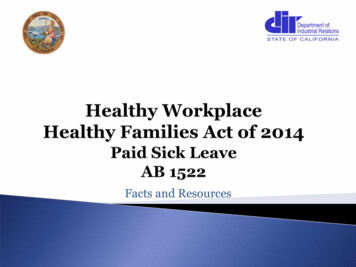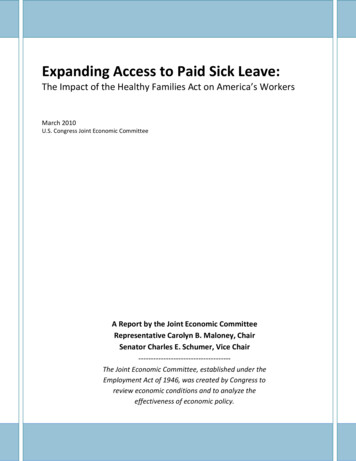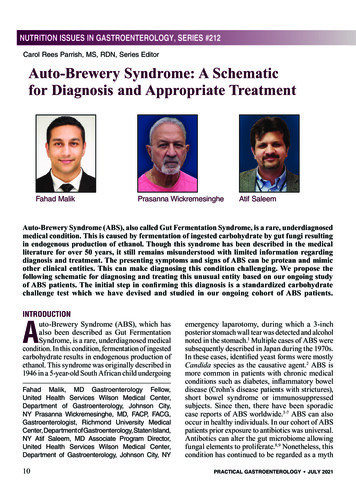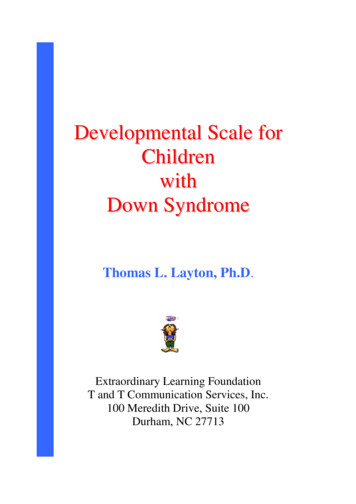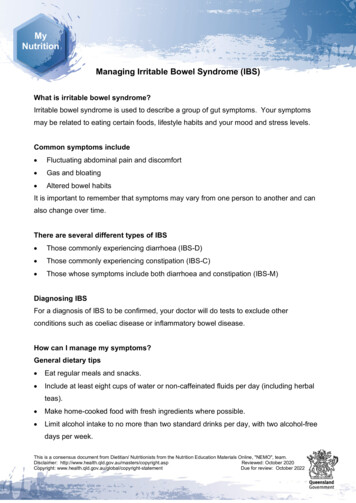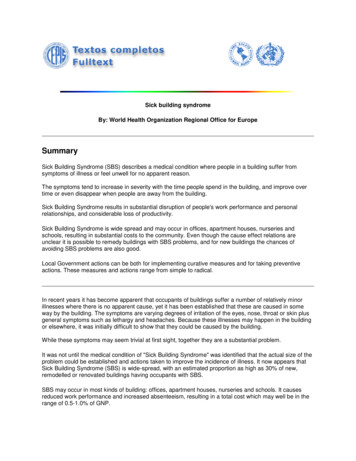
Transcription
Sick building syndromeBy: World Health Organization Regional Office for EuropeSummarySick Building Syndrome (SBS) describes a medical condition where people in a building suffer fromsymptoms of illness or feel unwell for no apparent reason.The symptoms tend to increase in severity with the time people spend in the building, and improve overtime or even disappear when people are away from the building.Sick Building Syndrome results in substantial disruption of people's work performance and personalrelationships, and considerable loss of productivity.Sick Building Syndrome is wide spread and may occur in offices, apartment houses, nurseries andschools, resulting in substantial costs to the community. Even though the cause effect relations areunclear it is possible to remedy buildings with SBS problems, and for new buildings the chances ofavoiding SBS problems are also good.Local Government actions can be both for implementing curative measures and for taking preventiveactions. These measures and actions range from simple to radical.In recent years it has become apparent that occupants of buildings suffer a number of relatively minorillnesses where there is no apparent cause, yet it has been established that these are caused in someway by the building. The symptoms are varying degrees of irritation of the eyes, nose, throat or skin plusgeneral symptoms such as lethargy and headaches. Because these illnesses may happen in the buildingor elsewhere, it was initially difficult to show that they could be caused by the building.While these symptoms may seem trivial at first sight, together they are a substantial problem.It was not until the medical condition of "Sick Building Syndrome" was identified that the actual size of theproblem could be established and actions taken to improve the incidence of illness. It now appears thatSick Building Syndrome (SBS) is wide-spread, with an estimated proportion as high as 30% of new,remodelled or renovated buildings having occupants with SBS.SBS may occur in most kinds of building: offices, apartment houses, nurseries and schools. It causesreduced work performance and increased absenteeism, resulting in a total cost which may well be in therange of 0.5-1.0% of GNP.
Even though the cause-effect relations are unclear, experience shows that it is possible to take measuresto remedy established buildings with SBS problems. For new buildings, the chances of avoiding SBSproblems are also good if sufficient attention is given at an early stage. A local authority can take actionswhich will make a big contribution to reducing the number of people with Sick Building Syndrome in itsarea.Sick Building Syndrome symptomsModern people spend most of their time indoors in houses, day-care centres, schools, offices and otherbuilding facilities. This means that if they are unwell, they will suffer symptoms and discomfort whileindoors, only some of which may be related to the buildings they occupy.Sick Building Syndrome can be identified where people in a building experience, more frequently thanexpected, a range of common symptoms causing discomfort and a sense of being unwell.The most common symptoms are the following: irritated, dry or watering eyes (sometimes described as itching, tiredness, redness,burning or difficulty wearing contact lenses),irritated, runny or blocked nose (sometimes described as congestion, nosebleeds, itchyor stuffy nose),dry or sore throat (sometimes described as irritation, upper airway irritation or difficultyswallowing),dryness, itching or irritation of the skin, occasionally with a rash,less specific symptoms such as headache, lethargy, irritability and poor concentration.Typically several of these symptoms are experienced simultaneously and they are often accompanied bycomplaints about stuffiness, poor air, dry air, noise, light or temperatures which are too hot or too cold.For some illnesses clear-cut connections to the building have been recognized. These are not included inSBS: infections such as colds and those that emanate from sanitary equipment,chronic illness caused by tobacco smokepoisoning from building materials such as lead in paint,legionellosis,effects of pollutants from industrial processes,cancer from radonasbestos-related diseases,general effects of dampness,thermal comfort effectshearing loss from noise.
In other situations, however, they are health problems which seem to be building-related, but where thereis no apparent cause requiring attention. The recent identification of the Sick Building Syndrome as amedical condition has provided the focus to allow local government to deal with the problem. A buildingwhere there are a substantial number of people with SBS symptoms is referred to as a "sick building".Sick Building Syndrome in EuropeThe common feature of sick buildings is that their occupants suffer, or appear tu suffer, a measurablyhigher incidence of symptoms of illness or discomfort than can reasonably be expected. A sick buildingmay result from the way in which the building is designed and constructed or from the way it is operated,maintained and used. Since the causes of SBS have not been identified, the best way of finding out ifthere is a problem is to look at the frequency of complaints or symptoms of illness.SBS reports from various European countries show that this is a widespread problem. According to aWHO expert group in the mid-1980s. up to 30% of new or remodelled buildings may have unusually highrates of complaints. This conclusion has been supported by many other studies.The recognition of SBS as an illness varies from country to country and the characteristics that areincluded in reports also vary considerably between countries. However, it is apparent that the sumptoms
occur in various kinds of building: offices, apartment houses, nurseries and schools. For example, arecent enquiry among 10,000 people living in Stockholm, Sweden, revelated that 13% of those living inapartment buildings complain about health problems which they relate to the indoor environment. OtherSwedish studies indicate still more frequent malfunctions, for example complaints in some 25% of allkindergartens in Stockholm and 20% of all kindergartens in Stockholm and 20% of all municipal buildingsin the city of Malmö.A major survey of the indoor climate in more than 3000 Swedish homes, in both single units and buildingscontaining multiple dwellings, has recently been carried out. The report from this project reveals that onein ten residents in buildings containing multiple residences complains about stuffy air, dry air, noise, dustand dirt. The situation appears to be considerably better in single family homes that were constructedafter 1975. In this study the most frequent symptom was tiredness. In every third or fourth case thesumptoms are presumed to be related to the residential indoor climate.Health implicationsSBS is a problem which can be removed or prevented. It is an unnecessary cause of ill-health withconsiderable loss of productivity and quality of life for those affected.For people affected by SBS the symptoms can cause substantial disruption to both their workperformance and personal relationships. This will have a major impact on productivity in the work place,which is shown in reduced performance, increased absenteeism, reduced overtime, increased staffturnover and demands on management and trade unions trying to resolve the problem. British estimatesfrom various studies indicate that up to 8% of the working population regularly experience SBS symptomstu such an extent that their health and productivity are seriously affected. It is important to remember,however, that the symptoms of SBS can be regarded as minor, since recovery is usually quite rapid assoon as the problem is identified and remedial measures taken.When sick building problems occur in kindergartens, schools and hospital where the individuals are moresensitive and spend a large amount of time, the situation should be regarded as of great concern.
Economic aspectsThe total cost of SBS on a country's economy has not been comprehensively studied, although estimatesindicate it is likely to be substantial. Extreme cases of buildings being closed or demolished are rare. Themost obvious costs of SBS are due to increased absenteeism and increased staff turn-over. Economiccosts, which are very difficult to assess, are those due to reduced work performance, the use ofmanagement time to deal with complaints, and time and costs involved in trying to establish and eliminatethe problems.
In a British study of a particularly troublesome large office building, the loss of productivity is subjectivelyestimated to range from 3% for staff taking "sick leave" up to 33% for staff who are "sometimes lessproductive".An American study estimated that the total cost of SBS may range from US 5 billion up to several tens ofbillions for the USA. If the costs for health care, social security and building works are added, the totalmay be 0.5-1.0% of GNP.A moderate assumption from these figures is that 1 day per person per year is lost through sick leave,productivity loss,extended breaks, etc. Another 1 hour per month is required for dealing with problems.Together this adds up to 1% of total staff time.Features of sick buildingsIn general, the specific causes of SBS for any individual cannot be identified. Nevertheless, whenanalysing the overall experience in this area it seems that the problems fall into four broad categories: location factors,problems related to the fabric of the building or its contents and building services. Theseinclude chemical emissions from building materials and furniture as well as things likelighting and heating.
problems unrelated to the structure of the building but which occur while in the building.The best example of these is allergy where the cause may be pollen, dust or mould,problems which can be described as psychological.These may be caused by organizational or social conditions or even physical objects orthe work space.The following list provides a set of building characteristics which are often found in sick buildings. Theseshould be considered for both houses and other buildings when investigating a building where a numberof the occupants have the symptoms of SBS. It should, however, be noted that not all sick buildings haveall these features, and not all buildings with these features will be sick. built during the 1960s or laterair conditioning with cooling capacitylighting causing high glare and/or flickerlow level of user control over ventilation, heating and lightinglarge areas of soft furnishinglarge amount of open shelving and filingnew furniture, carpets and painted surfacespoor standards of maintenance and repairinsufficient cleaninghigh temperature or excessive variations in temperature during the dayvery low or very high humiditychemical pollutants such as tobacco smoke, ozone or volatile organic compounds frombuilding materials and furnishingdust particles and fibres in the aircomputer display screens
If the building being investigated is an office building with SBS problems, the following characteristics canalso be significant: deep plan or oper plan offices of more than about 10 work stationsmany people working with display screensworkers most affected by the symptoms tend to be those in routine clerical jobsIt should be noted that single factors are unlikely to cause the symptoms and that complicated interactivecauses are highly probable. It may be extremely difficult to identify all the causes, and in some cases thecause may never be identified even when the problem is fixed.
WHO PositionMany different terms have been used to describe the phenomenon of reported high incidence of illness orunwellness suffered by people for no apparent reason in certain buildings; these include "buildingsickness", "sick office syndrome", "tight-building syndrome" and "office-eye syndrome".In 1982 the World Health Organization agreed the term "Sick Building Syndrome" (SBS), and this is nowthe most widely used.WHO has produced some very useful publications on indoor air quality which are available from theRegional Office for Europe.Recommendation 1Local Government action to improve sick buildingsSick building syndrome may become a local governmet issue, either because of problems in a buildingowned or occupied by local governmet staff or because of complaints that the owner of a building in thearea is not responding to complaints by the occupiers or tenants of a building.If there may be SBS problems in a building, a suggersted plan would be to:
Design a procedure and give one member of staff overall responsibility forcollecting and classifying complaints about indoor climate and symptoms of ill-health.It is often better for an autside organization to carry out staff surveysEstablish a systematic approach to dealing with problems, which should involveidentifying possible causes and dealing with them without delay. The key areas are:- looking for simple causes such as breakdown in the ventilation system- considering changes in work environment or processes employed- paying particular attention to cleaning the buildingIf simple measeures do not work, then seek expert help.Recommendation 2Local government action to prevent the construction of new sick buildingsIn approving or agreeing to a building plan, the local government priorities should be to: Ensure the proposed building site does not have hidden problems, such as waterclose to the surface or contamination from previous uses.Make sure that designers ensure known risk factors are taken into account. Thiswill require professionals to work as a team when determining facility layout, use ofmaterials, machinery and thermal properties, and ensuring the building is designed foreasy cleaning.Check local air quality before deciding or approving standards of ventilation and airtightness.Check the building and its services before it is brought into use.Further readingIndoor Air Quality Research. Copenhagen, World Health Organization, 1986. (EURO Reports andStudies N . 103).Indoor Air Quality : Organic Pollutans. Copenhagen, World Health Organization, 1989. (EURO Reportsand Studies N .111).Indoor Air Quality : Biological Contaminants. Copenhagen, World Health Organization, 1990. (WHORegional Publications, European Series N .31).Technical AnnexTable of content Improving sick buildings-Cleaning-Ventilation-Contributing comfort factors-Management and use of buildings-Phychological factors
Avoiding sick buildings-Local planning-General building design-Installation systems-Control,evaluation and feedbackBackground information on micro-biological and chemical pollutants-Microbiological pollutants-Chemical emissionsReferencesImproving sick buildingsContinual complaints about indoor climate or about symptoms of ill-health will often mean that there areproblems with the building of the type which are associated with SBS.Neglecting complaints will in the long run result in the problems growing worse, increased losses inproduction and increased lossess in production and increased costs of remediation.Furthermore, the absence of action may cause irritation, suspicion and distrust amog the workers oroccupants.Changes in an existing building will at best take considerable effort and in the worst case may requirereplacement of the building. It is therefore well worth using a systematic approach to ensure that action islikely to be effective in solving the problems. The general approach is autlined.Good practice is to appoint a staff member with overall responsibility for collecting and classifyingcomplaints and for planning all actions. All staff occupying the building should know who the responsibleperson is and how to lodge complaints.Recording complaints should include every complaint related to indoor climate, even those which arevague or diffuse. Symptoms of ill-health, particularly minor ones, will usually not be reported. Reportsabout reduced efficiency should also be recorded. The person responsible for recording complaintsshould regularly review the situation.When te review of complaints suggests that a problem exists, an investigation to identify the extentand nature of the problem should be carried out. Normally the first part of the investigation willcomprise visiting the facilities in question and talking to people about the situation.Questions about both the complaints and symptoms of ill-health should be asked.Important questions at this stage are the following: what are the symptoms?how frequently and when do symptoms occur?do symptoms decrease after leaving the building?do variations between parts of the building exist?People's answers often may indicate one or more probable cause of the problems. Look first for the mostcommon explanations: new or increased pollutantsventilation breakdownsepidemics of colds
changes in work processesIf simple solutions are indicated, these should be applied without delay, e.g. to repair or changeventilation components, to adjust temperatures, or to improve cleaning.These issues are discussed in more detail below.When the problem seems more complicated or when the simple actions are not sufficient, morecomprehensive studies are needed.These should include a general enquiry among the users, preferably using one of the models developedby a number of expert organisations.Technical surveys should include measuring air humidity, temperature, air supply rates, air velocities andthe concentration of carbon oxides.Again some rather simple actions may possibly solve the problems, for example balancing the ventilationsystem or arranging separate extract ventilation from office machinery and smoking rooms.
It is essential that information about the investigation is given to all the people concerned. Whenthe solutions will take time to implement, user involvement by a project group is often useful. Monitoringof complaints and symptoms during the investigation must be carried out.If the problems remain unsolved, expert help should be sought. It is very probable that specificchemical and biological measurements are needed or that substantial changes in the building arerequired. Doing the wrong thing may result in high costs and even increase the problems.Suitable professionals may be building service engineers, medical experts, occupational hygienists andmanagement specialists.CleaningThere is growing evidence that indoor surface pollution is one of the main causes of SBS. The surfacepollution is more than settled dust; it is also made up of all the contaminants given off by the building'susers, its contents and services. This includes chemical and microbiological contaminants which settle onsurfaces, as well as skin scales, debris from shoes and products from food, smoking and drinking.A survey by the UK Building Research Establishment found that reducing indoor surface pollution helpedto reduce SBS.Good cleaning should pay special attention to areas which are damp or wet and where papers and booksare stored. If possible, methods that do not raise dust should be used.Ventilation systems (ducts, filters and grills) and hidden areas (above false ceilings and below falsefloors) should be regularly cleaned. Where large areas of solt surfaces occur, chemical methods may beneeded to kill dust mites if they are found to be present.However, the need for enhanced or specialized cleaning, which is very expensive, can be reduced andthe task of cleaning made easier by paying attention to design, furniture selection and general layout.Managing the source of pollution is better than continually removing the pollution as it occurs, e.g. byavoiding open storage areas and the use of excessive furniture fabrics. Measures should also be taken tofacilitate the access of the cleaning staff to all areas.
VentilationVentilation has two purposes, to provide fresh air and to remove or dilute pollution. This requiresadequate air flow while excessive flow will cause draught, noise and other comfort problems. Heavilypolluted air may therefore be difficult to manage.Shortcomings of the ventilation system are apparent in many instances of SBS. The most commonproblem is that the ventilation system has been wongly adjusted, creating an imbalance between therooms in the building, which may lead to pollution being disseminated or insufficiently diluted in somerooms.Another cause of low air flow and pollutants in the air is dirt in the ventilation ducts. This may dependupon the design of the sistem, for example if installations are difficult to reach, inspection panels aremissing or components are poorly designed.Modern ventilation systems are usually complicated and demand precise instructions for operation andmaintenance. In fact, several studies show that adequate documentation is uncommon, and that SBSsymptoms are less frequent where the users themselves can control the ventilation.
Contributing comfort factorsA number of interrelated physical factors such as noise, uncomfortable temperatures, low relativehumidity, and poor lighting may have acumulative effect and make SBS more likely.Noise may play a complex role. High levels disturb communication and concentration and hencecontribute to lethargy, headache, etc. The effects of low frequency noise, e.g.from ventilation systems,are not sufficiently known but have been associated with SBS symptoms.Higher temperatures are unlikely to directly cause symptoms but may stimulate material emissions andgrowth of bacteria, fungi and dust mites. Field studies have shown that SBS symptoms can increase asthe temperature rises above 21 C.Case studies and controlled tests have shown that humidification which increases relative humidity toabove about 30% can reduce symptoms. This has, however, to be balanced against increased humiditypromoting growth of micro organisms.Lack of natural light may also be a contributory factor and tests have shown those seated near a windowtend to suffer less from SBS, although the link is not clear. Subliminal flicker from fluorescent tubes hasbeen shown to contribute toward headaches and eye-strain and elimination of the flicker has been shownto reduce the symptoms.Management and use of buildingsIn general, buildings with poor maintenance (hygiene and operation) and insufficient cleaning are morelikely to show SBS symptoms.Modern indoor climate technology is often complicated. In order to ensure the proper temperature and airsupply, the operation staff should receive proper training to maintain the systems and have access tocomprehensive instructions on how maintenance, function tests and adjustments should be carried out.In many cases, user activities have been proven to expose the buildings to strains that they were notdesigned to endure. Changes of use of the building - e.g. changed office partitioning or adding newequipment such as computers, printers and photocopiers - may heavily increase the load of heat andpollution. Every major change should therefore be discussed with the building managers andprofessionals familiar with building problems.
Psychological factorsIt appears that stress may increase the susceptibility of individuals to SBS, which is shown by increasedcomplaints about discomfort or illness. The cause may be general job stress or inadeaquate managementof the work or living environment by those responsible for the building. However the symptoms arecaused, they do result in problems for the individual and will result in reduced productivity and loss ofquality of life. Until there is more knowledge about human reactons to substances, or to the combinationof factors which individually do not cause ill-health or discomfort, SBS must not be dismissed "due topsychological causes" and no further action taken.Several studies imply that there is a relationship between SBS symptoms and poor general management,poor management of staff complaints or low general staff satisfaction with job or organisation.Organisational changes may therefore be an effective way to deal with SBS problems.Studies have also shown that women and staff in routine and low paid jobs are more likely to suffer fromSBS than others. This may be because lack of personal control tends to decrease people's tolerance ofpoor indoor environments.Avoiding sick buildingsReducing the hazards before a new building is occupied can greatly reduce the losses in time and wellbeing resulting from SBS. Until SBS is better understood as the result of further research we must rely onthings which have been shown to work in the past. It is essential that every new building andrefurbishment project is carefully planned and managed.Local authorities may play various roles in the building process : as planning bodies, as educartors, ascontrolling bodies, as purchasers, and as owners and managers. These roles differ from country tocountry, which means the following general advice must be used when applicable in the local situation.Local Planning
Local planners should be throughly aware that not all land is suitable to be built upon. Problems that arelikely to be caused by type of ground or climate can be avoided. Building plans should always be basedon geotechnical investigations, with areas containing high levels of radon gas or high sub-soil water levelsavoide. Similarly, landfill sities, highly containated land and noisy areas should be avoided.Concern should also be given to the air quality of the surroundings.Locations near industrial areas or heavy traffic will generally need more stringent requirements onventilation systems and air tight buildings.General building designThere is an obvious relation between the activities within a building and the technical requirements thatthe building must satisfy. It is therefore essential that each building project is described by specificationswhich identify what the activities are, how they relate to one another, and what the generation of heat,moisture and pollutants is likely to be. The project specifications should also define what skills andcompetences are needed in the project and demand a plan for organised interaction between the variousprofessionals.Often too little attention is paid to the long-range characteristics of the building. The building specificationsshould explicity require that desing teams consider, document and explain the expected life-cycle ofsystems and components. the need for maintenance and how operation and monitoring should be carriedout.From the evidence to date, there are some risk factors which have been identified and which should beavoided if possible. These include: open plan offices of more than about ten work stations,lightweight thermal properties and/or poor insulation,poor provision for daylight and/or uncontrolled solar gain,sealed windows,large areas of soft furnishing, open shelving and filing,use of inadequately tested materials, paints, joining mastics, and glues,luminate type lighting and position giving glare and flicker,services and areas not designed for easy cleaning and maintenance.Installation systemsAmong the requirements on modern buildings is that of energy efficiency, which is met by moreinsulation, increased air tightness and controlled air flows. It is very important that the interaction betweenair tightness, ventilation and emissions is understood. A relatively small mistake in one area may bereinforced elsewhere and create a substantial problem. Key factors in this area are the following: provision of sufficient fresh air (at least 8 litres per second per person in non-smokingareas and up to 30 in smoking areas)air inlets that are not close to exhaust or outdoor pollution sources and that are suppliedwith adequate filtrationremoval or dilution of airborne pollutants (e.g.separate extract ventilation from officemachinery and smoking rooms)provision of a comfortable temperature, related to the activities in the building
prevention of air stagnation and draughts (air flow rates 0.12-0.3 m/s)Control, evaluation and feedbackIt is essential that the critical functions of the building and its sub-systems are tested before a newbuilding is occupied. Experience shows that delayed completion often leads to occupancy withoutadequate testing.An essential part of the building programme is therefore a control plan, where relevant checkpoints aredefined. This plan should include how inspections are to be undertaken, and how these should bedocumented.Procedures for changes of materials and designs during design and construction should be defined.In areas where dampness is believed to contribute to SBS problems, allowing sufficient drying time forconcrete constructions is issential as well as control of how moisture protection is carried out. Properstorage of materials at the building site should also be specified.Building designers rarely get feedback from the building in use. One way to achieve improved feedback isto set up a meeting between designers, contractors and the operations and management staff withinabout 12 months of the building coming into operation. The meeting should be based on a systematicdocumentation of problems and errors as well as the good features.
Background information on microbiological and chemical pollutantsMicrobiological pollutantsPeople who suffer from allergy and hypersensitivity generate a substantial part of the complaints. Recentstudies have shown that the number of people suffering from an allergy or other hypersensitivity hasincreased. In a couple of decades the frequency of asthma has doubled among 19 year old Swedishmen.Hypersensitivity reactions are twice as common among pre-school children as among adults. A similardevelopment has been reported from other countries.
Most hypersensitivity reactions can be related to organic substances. A certain part of
which will make a big contribution to reducing the number of people with Sick Building Syndrome in its area. Sick Building Syndrome symptoms Modern people spend most of their time indoors in houses, day-care centres, schools, offices and other building facilities. This means that if they are unwell, they will suffer symptoms and discomfort while

